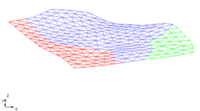GMS:2D Mesh Display Options: Difference between revisions
From XMS Wiki
Jump to navigationJump to search
No edit summary |
No edit summary |
||
| Line 5: | Line 5: | ||
! width="125" | Display Option !! Description | ! width="125" | Display Option !! Description | ||
|- | |- | ||
| Nodes || | | Nodes || Used to display mesh nodes. A small circle is drawn at each node. | ||
|- | |- | ||
| Element edges || | | Element edges || Used to display the edges of elements. The elements can be drawn using either the default color for elements or using the color of the material associated with each element. | ||
The color of the element edges can be adjusted according to the following options: | The color of the element edges can be adjusted according to the following options: | ||
| Line 16: | Line 16: | ||
| Element faces || This option fills the elements with the material color. | | Element faces || This option fills the elements with the material color. | ||
|- | |- | ||
| Texture map image || | | Texture map image || Used to "drape" an image over the surface of the 2D Mesh. | ||
|- | |- | ||
| Mesh boundary || | | Mesh boundary || Used to display a solid line around the perimeter of the mesh. Displaying the boundary is useful when contours are being displayed with the element edges turned off. | ||
|- | |- | ||
| Node numbers || | | Node numbers || Used to display the ID associated with each node next to the node. | ||
|- | |- | ||
| Element numbers || | | Element numbers || Used to display the ID associated with each element at the centroid of the element. | ||
|- | |- | ||
| Thin elements || | | Thin elements || When set, triangular elements with small aspect ratios are highlighted. The minimum aspect ratio can be set using the '''Aspect Ratio''' command in the ''Modify Mesh'' menu. | ||
|- | |- | ||
| Scalar values || | | Scalar values || Used to display the scalar values of the active dataset for each node next to the node. | ||
|- | |- | ||
| Contours || Most of the objects supported by GMS can be contoured by turning on the [[GMS:Contour Options| | | Contours || Most of the objects supported by GMS can be contoured by turning on the [[GMS:Contour Options|''Contourd'' option]] in the ''Display Options'' dialog. When an object is contoured, the values associated with the active dataset for the object are used to generate the contours. | ||
|- Vectors || If the [[GMS:Vectors|Vectors]] item in the ''Display Options | |- Vectors || If the [[GMS:Vectors|Vectors]] item in the ''Display Options'' dialog is selected for an object (TIN, Grid, or Mesh), vector plots can be generated using the active vector dataset for the object. One vector is placed at each node, cell, or vertex. | ||
|} | |} | ||
